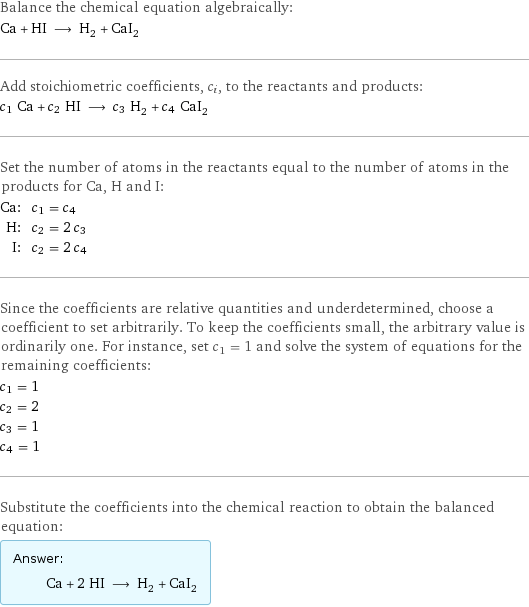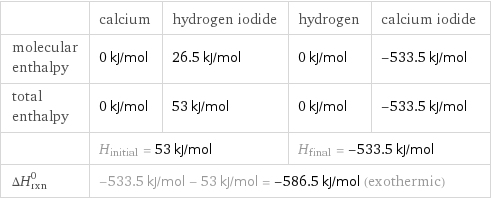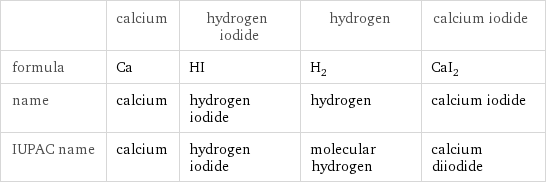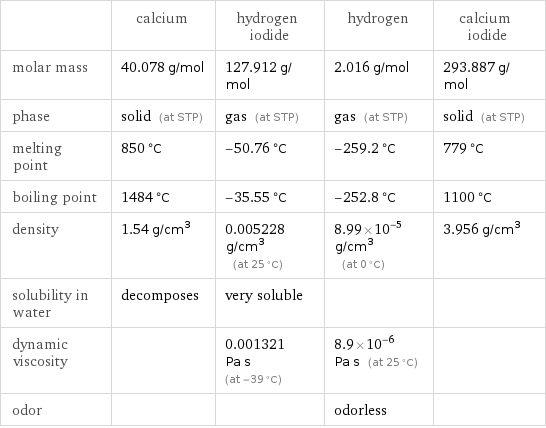Input interpretation

Ca calcium + HI hydrogen iodide ⟶ H_2 hydrogen + CaI_2 calcium iodide
Balanced equation

Balance the chemical equation algebraically: Ca + HI ⟶ H_2 + CaI_2 Add stoichiometric coefficients, c_i, to the reactants and products: c_1 Ca + c_2 HI ⟶ c_3 H_2 + c_4 CaI_2 Set the number of atoms in the reactants equal to the number of atoms in the products for Ca, H and I: Ca: | c_1 = c_4 H: | c_2 = 2 c_3 I: | c_2 = 2 c_4 Since the coefficients are relative quantities and underdetermined, choose a coefficient to set arbitrarily. To keep the coefficients small, the arbitrary value is ordinarily one. For instance, set c_1 = 1 and solve the system of equations for the remaining coefficients: c_1 = 1 c_2 = 2 c_3 = 1 c_4 = 1 Substitute the coefficients into the chemical reaction to obtain the balanced equation: Answer: | | Ca + 2 HI ⟶ H_2 + CaI_2
Structures

+ ⟶ +
Names

calcium + hydrogen iodide ⟶ hydrogen + calcium iodide
Reaction thermodynamics
Enthalpy

| calcium | hydrogen iodide | hydrogen | calcium iodide molecular enthalpy | 0 kJ/mol | 26.5 kJ/mol | 0 kJ/mol | -533.5 kJ/mol total enthalpy | 0 kJ/mol | 53 kJ/mol | 0 kJ/mol | -533.5 kJ/mol | H_initial = 53 kJ/mol | | H_final = -533.5 kJ/mol | ΔH_rxn^0 | -533.5 kJ/mol - 53 kJ/mol = -586.5 kJ/mol (exothermic) | | |
Equilibrium constant
![Construct the equilibrium constant, K, expression for: Ca + HI ⟶ H_2 + CaI_2 Plan: • Balance the chemical equation. • Determine the stoichiometric numbers. • Assemble the activity expression for each chemical species. • Use the activity expressions to build the equilibrium constant expression. Write the balanced chemical equation: Ca + 2 HI ⟶ H_2 + CaI_2 Assign stoichiometric numbers, ν_i, using the stoichiometric coefficients, c_i, from the balanced chemical equation in the following manner: ν_i = -c_i for reactants and ν_i = c_i for products: chemical species | c_i | ν_i Ca | 1 | -1 HI | 2 | -2 H_2 | 1 | 1 CaI_2 | 1 | 1 Assemble the activity expressions accounting for the state of matter and ν_i: chemical species | c_i | ν_i | activity expression Ca | 1 | -1 | ([Ca])^(-1) HI | 2 | -2 | ([HI])^(-2) H_2 | 1 | 1 | [H2] CaI_2 | 1 | 1 | [CaI2] The equilibrium constant symbol in the concentration basis is: K_c Mulitply the activity expressions to arrive at the K_c expression: Answer: | | K_c = ([Ca])^(-1) ([HI])^(-2) [H2] [CaI2] = ([H2] [CaI2])/([Ca] ([HI])^2)](../image_source/fbb9941431ca542ef664eda8836815a0.png)
Construct the equilibrium constant, K, expression for: Ca + HI ⟶ H_2 + CaI_2 Plan: • Balance the chemical equation. • Determine the stoichiometric numbers. • Assemble the activity expression for each chemical species. • Use the activity expressions to build the equilibrium constant expression. Write the balanced chemical equation: Ca + 2 HI ⟶ H_2 + CaI_2 Assign stoichiometric numbers, ν_i, using the stoichiometric coefficients, c_i, from the balanced chemical equation in the following manner: ν_i = -c_i for reactants and ν_i = c_i for products: chemical species | c_i | ν_i Ca | 1 | -1 HI | 2 | -2 H_2 | 1 | 1 CaI_2 | 1 | 1 Assemble the activity expressions accounting for the state of matter and ν_i: chemical species | c_i | ν_i | activity expression Ca | 1 | -1 | ([Ca])^(-1) HI | 2 | -2 | ([HI])^(-2) H_2 | 1 | 1 | [H2] CaI_2 | 1 | 1 | [CaI2] The equilibrium constant symbol in the concentration basis is: K_c Mulitply the activity expressions to arrive at the K_c expression: Answer: | | K_c = ([Ca])^(-1) ([HI])^(-2) [H2] [CaI2] = ([H2] [CaI2])/([Ca] ([HI])^2)
Rate of reaction
![Construct the rate of reaction expression for: Ca + HI ⟶ H_2 + CaI_2 Plan: • Balance the chemical equation. • Determine the stoichiometric numbers. • Assemble the rate term for each chemical species. • Write the rate of reaction expression. Write the balanced chemical equation: Ca + 2 HI ⟶ H_2 + CaI_2 Assign stoichiometric numbers, ν_i, using the stoichiometric coefficients, c_i, from the balanced chemical equation in the following manner: ν_i = -c_i for reactants and ν_i = c_i for products: chemical species | c_i | ν_i Ca | 1 | -1 HI | 2 | -2 H_2 | 1 | 1 CaI_2 | 1 | 1 The rate term for each chemical species, B_i, is 1/ν_i(Δ[B_i])/(Δt) where [B_i] is the amount concentration and t is time: chemical species | c_i | ν_i | rate term Ca | 1 | -1 | -(Δ[Ca])/(Δt) HI | 2 | -2 | -1/2 (Δ[HI])/(Δt) H_2 | 1 | 1 | (Δ[H2])/(Δt) CaI_2 | 1 | 1 | (Δ[CaI2])/(Δt) (for infinitesimal rate of change, replace Δ with d) Set the rate terms equal to each other to arrive at the rate expression: Answer: | | rate = -(Δ[Ca])/(Δt) = -1/2 (Δ[HI])/(Δt) = (Δ[H2])/(Δt) = (Δ[CaI2])/(Δt) (assuming constant volume and no accumulation of intermediates or side products)](../image_source/65f32de89b7a5ecf1bce6396ae1fa187.png)
Construct the rate of reaction expression for: Ca + HI ⟶ H_2 + CaI_2 Plan: • Balance the chemical equation. • Determine the stoichiometric numbers. • Assemble the rate term for each chemical species. • Write the rate of reaction expression. Write the balanced chemical equation: Ca + 2 HI ⟶ H_2 + CaI_2 Assign stoichiometric numbers, ν_i, using the stoichiometric coefficients, c_i, from the balanced chemical equation in the following manner: ν_i = -c_i for reactants and ν_i = c_i for products: chemical species | c_i | ν_i Ca | 1 | -1 HI | 2 | -2 H_2 | 1 | 1 CaI_2 | 1 | 1 The rate term for each chemical species, B_i, is 1/ν_i(Δ[B_i])/(Δt) where [B_i] is the amount concentration and t is time: chemical species | c_i | ν_i | rate term Ca | 1 | -1 | -(Δ[Ca])/(Δt) HI | 2 | -2 | -1/2 (Δ[HI])/(Δt) H_2 | 1 | 1 | (Δ[H2])/(Δt) CaI_2 | 1 | 1 | (Δ[CaI2])/(Δt) (for infinitesimal rate of change, replace Δ with d) Set the rate terms equal to each other to arrive at the rate expression: Answer: | | rate = -(Δ[Ca])/(Δt) = -1/2 (Δ[HI])/(Δt) = (Δ[H2])/(Δt) = (Δ[CaI2])/(Δt) (assuming constant volume and no accumulation of intermediates or side products)
Chemical names and formulas

| calcium | hydrogen iodide | hydrogen | calcium iodide formula | Ca | HI | H_2 | CaI_2 name | calcium | hydrogen iodide | hydrogen | calcium iodide IUPAC name | calcium | hydrogen iodide | molecular hydrogen | calcium diiodide
Substance properties

| calcium | hydrogen iodide | hydrogen | calcium iodide molar mass | 40.078 g/mol | 127.912 g/mol | 2.016 g/mol | 293.887 g/mol phase | solid (at STP) | gas (at STP) | gas (at STP) | solid (at STP) melting point | 850 °C | -50.76 °C | -259.2 °C | 779 °C boiling point | 1484 °C | -35.55 °C | -252.8 °C | 1100 °C density | 1.54 g/cm^3 | 0.005228 g/cm^3 (at 25 °C) | 8.99×10^-5 g/cm^3 (at 0 °C) | 3.956 g/cm^3 solubility in water | decomposes | very soluble | | dynamic viscosity | | 0.001321 Pa s (at -39 °C) | 8.9×10^-6 Pa s (at 25 °C) | odor | | | odorless |
Units
